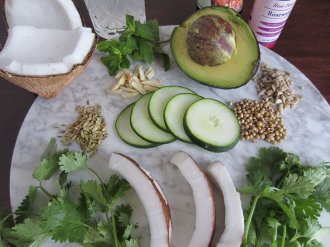
Ayurveda Diet Plan for Pitta
 Photo from: "Eat Well, Be Well: Ayurveda Cooking for Healthy Living” by Lois Leonhardi
Photo from: "Eat Well, Be Well: Ayurveda Cooking for Healthy Living” by Lois Leonhardi
Pitta is balanced by a diet of fresh, whole foods (both cooked and raw) that are cooling, hearty, energizing, comparatively dry, and high in carbohydrates. These foods calm pitta by decreasing internal heat, preventing inflammation, balancing the digestive fire, grounding the body, and by absorbing excess liquid and oil. Because pitta is relatively substantive in nature, an appropriate diet is actually a very effective way to support a return to balance. What follows are some specific principles that we hope will empower you in discovering a pitta pacifying diet that works for you.
Qualities to Favor and Avoid
Pitta is oily, sharp, hot, light, spreading, and liquid, so eating foods that neutralize these qualities – foods that are dry, mild, cooling, grounding, stabilizing, and dense – serve to balance excess pitta. This section offers a closer look at the qualities of various foods. An improved understanding of these qualities can guide you in making specific dietary choices that will better support pitta.
Favor Cool over Warm or Hot
The cool quality can be emphasized by eating foods that are cool in temperature or that have a cooling energetic – and by using cooling spices generously. Most spices are heating in nature, so pay careful attention to which ones balance pitta (see our list of pitta pacifying spices). Raw foods tend to be naturally cooling, and pitta tends to be able to handle them better than the other doshas; so mixing in an assortment of raw fruits and vegetables is generally supportive – especially in the warmer months. On the other hand, it is best to avoid fiery hot dishes, foods with a sharply warming energetic, alcohol, and caffeine; all of these influences can increase heat.
Favor Dense, Grounding, and Nourishing Over Light
While the heavy quality is the true antithesis to pitta’s lightness, Ayurveda teaches us that very heavy foods (such as deep-fried foods) are not generally supportive of optimal health. It’s better to think in terms of grounding pitta’s lightness (and heat) with sustenance – eating foods that offer solid, stabilizing sources of energy and adequate nourishment to the physical body. Generally, these foods will naturally taste sweet. Most grains, milk, root vegetables, seeds, and cooling oils are good examples. But, pitta tends to have a sharp and sometimes insatiable appetite, so it’s equally important not to overindulge. Highly processed foods such as canned foods, ready-made meals, and pastries often lack prana (vital life force), are excessively heavy, and should be avoided.
Favor Dry and Dense Over Oily or Liquid
Pitta’s liquid nature and tendency toward excess oil make drying or astringent foods like beans, potatoes, corn, millet, oats, pasta, popcorn, and most vegetables very appropriate. When cooking, use a moderate amount of a high quality oil or ghee. Reduce or eliminate especially heating oily foods like eggs, hard cheeses, olives, nuts, sour cream, and the like. If given a choice between a soupy, liquidy meal and one that is denser and drier, opt for the latter. For example, have baked tofu served over steamed greens and rice, rather than tofu miso soup.
Favor Mild over Sharp
Sharp flavors like pineapple, pickles, vinegar, and sharp aged cheeses are better replaced with milder, gentler tastes, like those found in apples, cucumbers, lime juice, and soft cheeses. Similarly, stimulants such as caffeine, nicotine, and hard alcohol are too sharp and penetrating for pitta. Substitute more stable and sustaining sources of energy.
Tastes to Favor and Avoid
Pitta is pacified by the sweet, bitter, and astringent tastes and aggravated by the pungent, sour, and salty tastes. Understanding these tastes allows us to better navigate a pitta pacifying diet without having to constantly refer to extensive lists of foods to favor and avoid.
Emphasize
Sweet
- The sweet taste is cooling and heavy but also anti-inflammatory. It pacifies heat, satisfies thirst, benefits the skin and hair, and tends to be grounding, nourishing, strength building, and satisfying.
- Emphasizing the sweet taste does NOT require us to eat large amounts of refined sugar or sugary sweet foods; naturally sweet foods are best.














